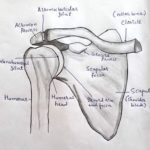Consider scapula for neck pain
We see neck pain regularly in our routine practice. Most of the time it is associated with shoulder pain/pathology.
We have patient complained of pain while looking down/up during ADL (activity of daily living). Those who spend extensive time with gadgets are more prone for neck pain.
Let’s understand what exactly happens when neck pain occurs….
Many times we do not check for scapula dysfunction during arm elevation. Scapula dysfunction is also a contributing factor in neck pain. When there is downward rotation with anterior tilt of scapula, there is tightness in pectoralis minor and insufficiency of lower trap and serratus anterior.
When there is downward rotation of scapula, levator scapula become
[restrict]overactive and upper trapezius become elongated and fatigue. Keep in mind upper trap doesn’t undergo shortening.Therefore neck muscles has to work hard to maintain scapula in its normal position.
Next time when patient comes to you with neck pain check his scapula position, do not directly start with stretching of upper trap. If you continue to stretch upper trap than you make it more inefficient to work because it is already lengthen. Check his levatorscap, pec minor, semi spenalis and other muscles.
According to shirley sahrmann,The upper trapezius muscle, through its attach ment to the ligamentum nuchae, can affect the cervical spine. An impairment is present if monitoring the spinous processes of the cervical vertebrae while the patient with neck pain flexes the shoulder indicates that the spinous processes rotate to the same side as the shoulder being flexed.
The most likely explanation for the rotation of the cervical vertebrae is that the cer- vical vertebrae are excessively flexible; thus when the upper trapezius muscle contracts, the spine rotates instead of remaining stable. This motion is often eliminated by bilateral shoulder flexion as the simultaneous bilateral contraction of the trapezius muscle stabilizes the spine. Most often, the cervical rotation occurring with shoulder flexion is seen only when one shoulder is moving.
I hope this will clear your doubt about neck pain what you should looking for.
[/restrict]
To read more register with us




Leave a Reply
Want to join the discussion?Feel free to contribute!